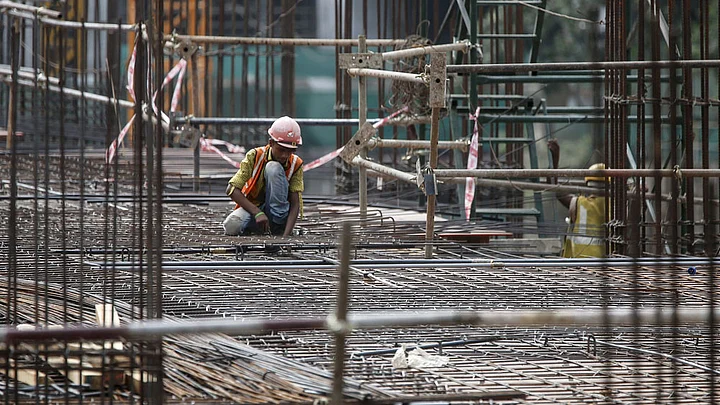Monsoon rainfall disappointed during the summer of 2015 but economic growth did not. India’s economy expanded a robust 7.4 per cent in the July-September quarter, a pick-up from the previous quarter when it grew 7.1 per cent, but slower than the 8.4 per cent expansion seen in the same quarter of 2014.
Nonetheless, India’s growth rate is currently the highest among the world’s 10 largest economies, outpacing China, which grew only 6.9 per cent in the same quarter. The US – the world’s largest economy – expanded 2.1 per cent in the July-September quarter. India’s economy has recovered from the lows of 2012-13, but there still persists some risks that may hamper its rapid expansion.
Risks to Growth
- Food inflation may remain elevated due to patchy monsoon
- Rural demand will remain weak due to drought in many districts
- Purchasing managers’ index and core sector industries index point to slowing manufacturing
- Weakness in the global economy to continue to hurt exports
Weak Monsoons to Keep Growth at Bay
The disappointing monsoon, for instance, is expected to haunt the economy in the next two quarters – agriculture output is bound to shrink further. Already crops have been lost due to insufficient rains in most parts of the country. The government has scaled down its estimates of full-year growth to 7.5 per cent from the Economic Survey’s forecast of 8 per cent for the current fiscal year. The Reserve Bank of India (RBI) estimate is a notch lower at 7.4 per cent.
Lower farm output will mean higher prices for consumers, fueling food inflation. It will also mean lower income for rural households, as farmers rarely get a share of the high prices that consumers pay. Rural distress is already visible in districts that experienced drought, people do not have enough money to buy essentials such as food. Given that more than half of India lives in rural areas, a fall in their income means shriveling of demand for a range of consumer goods – from television and refrigerators to motor-cycles and cars, all of which come from the manufacturing sector.
Manufacturing Sector Still a Big Worry
Thus, the robust manufacturing growth of 9.3 per cent seen during the July-September quarter, the fastest in three years, is unlikely to be sustained in the following quarters. The purchasing managers’ index, a leading indicator of economic activity, plunged to a 25-month low in October, indicating surplus inventory in the economy. Manufacturers typically ramp up production in the months ahead of the festive season anticipating a pick-up in sales. Car sales have remained strong so far, helped by the fall in fuel costs over the last one year.
There’s another indication of some trouble brewing in the manufacturing sector – the eight core sector industries index also reported a slowdown in October. Core sector growth stood at 3.2 per cent in October, from 9 per cent in the same month a year ago.
The manufacturing sector is also expected to take a small hit due to fall in demand from China and parts of the euro zone. So far, earnings from exports have plunged even though the overall volume of exports has not suffered much – but it may not be long before volumes too start shrinking. The manufacturing sector also faces risk from cheaper imports, especially those benefitted from the crash of commodity prices.
Many Blessings of Lower Oil Price
On the positive side, the fall in crude oil prices has been a blessing for the economy and the government. Cheaper crude has helped bring down inflation much faster than was planned. It has also helped the government raise taxes and thus increase its revenues during the current fiscal year. India’s cost of imports has declined to almost a third since last July, and the government used every opportunity it had to increase excise duty on petrol and diesel multiple times. As a result, the government’s revenues from excise duties have zoomed – it was nearly 70 per cent higher till end of October compared to the same period in the last fiscal year.
Falling crude oil price has also shrunk India’s subsidy bill – the subsidy on kerosene and liquefied petroleum gas has fallen to manageable levels. This augurs well for the country’s fiscal deficit and the government may manage to keep it within target of 3.9 per cent of GDP. It also means the government has more resources for public spending on development projects including infrastructure – all of which will help growth now and in future.
Bright Spots
- Crude oil prices are expected to remain subdued despite ISIS created conflicts
- That will keep oil subsidy level within manageable levels and fiscal deficit within target
- Falling commodity prices globally means lower input costs for manufacturing
- Government’s tax revenues are robust and so it can step up spending
Benign Oil, Gold Prices to Rein in Deficit
The decline in petroleum prices along with a fall in gold prices means the gap between imports and exports will narrow, and will keep the current account deficit low – at about 1 per cent of GDP. Global prices of both these commodities are expected to remain benign for different reasons. Increase in interest rates by the US Federal Reserve may see gold prices plunge further.
For the moment, most factories are operating below their capacity. And, there are very few businesses that are making fresh investments in new capacity creation. Construction activity too is weak, particularly in the housing sector where end-users are seeking out finished properties rather than investing in under-construction properties. The RBI estimates that the step-up in public capital spending and the accommodative monetary policy will provide an enabling environment for a revival in private investment demand. Expectations are that growth will improve in the next fiscal year.
(The writer is a Delhi-based senior journalist)
